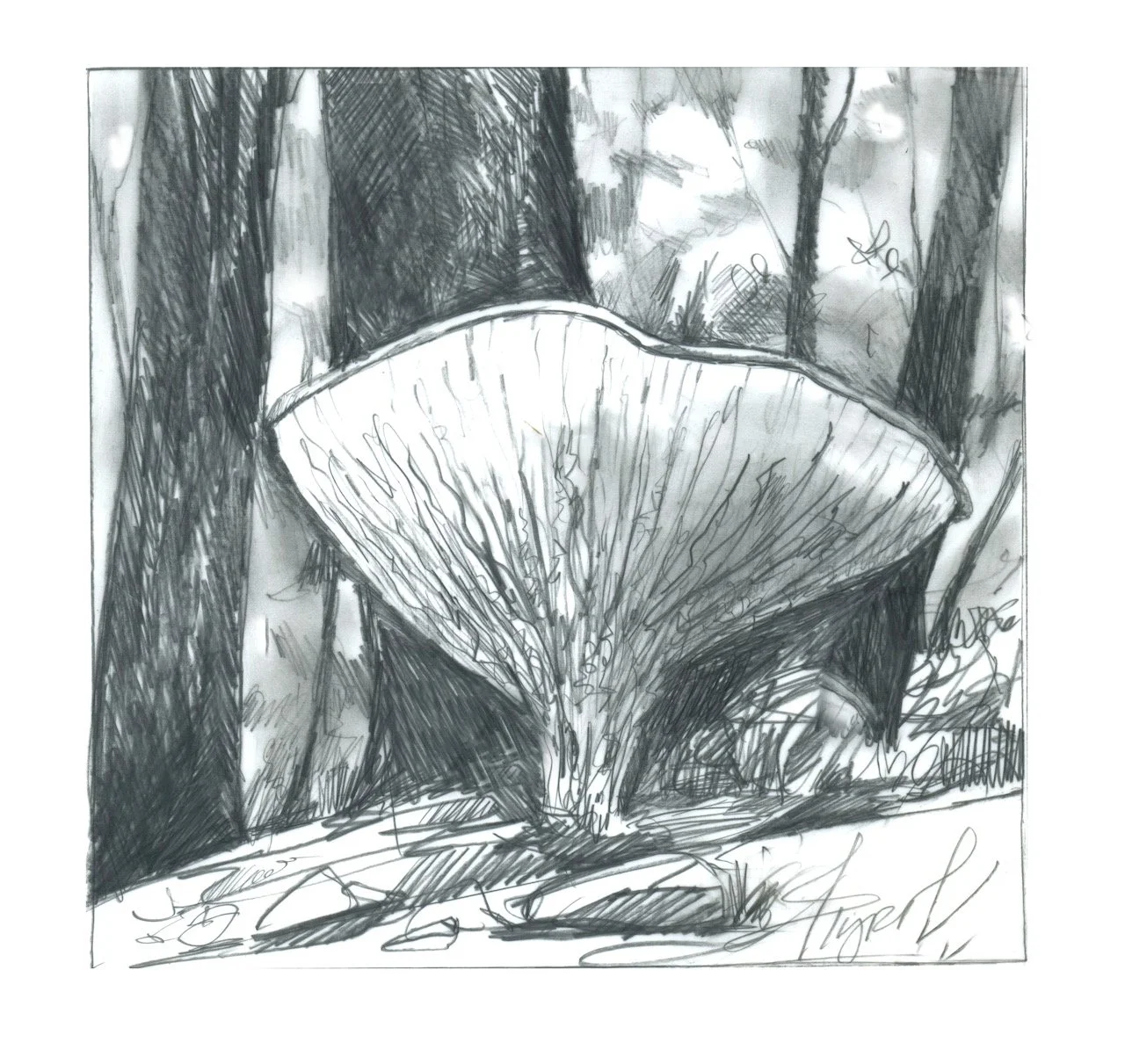The Outside Story: the tangled tale of the ash-tree bolete
Oct. 6, 2022 | By Rachel Sargent MirusIllustration by Adelaide Murphy Tyrol
If the enemy of my enemy is my friend, then surely the friend of my enemy is my enemy. This inverted cliche is one way to characterize the tangled relationship between ash trees and the ash-tree bolete.
The ash-tree bolete (Boletinellus merulioides) is a fan-shaped brown mushroom with an off-center stem. It grows in association with ash trees throughout eastern North America; however, that association is an odd one. Typically, when mushrooms consistently pop up near a particular species of tree, the fungus that produces those mushrooms has either a symbiotic or parasitic relationship with that tree species.
Yet when researchers took a close look at the ash-tree bolete fungus, they didn’t find either type of relationship. Instead, they discovered a secondary, symbiotic connection between the fungus and an ash enemy: an aphid that feeds exclusively on ash trees.
In 1987, mycologists Mark Brundrett and Bryce Kendrick, then at the University of Waterloo in Ontario, Canada, surveyed ash roots during a field study and found abundant ash-tree bolete sclerotia. Sclerotia are a hardened form of mycelia (the root-like structures which allow fungi to absorb nutrients).
In the ash-tree boletes Brundrett and Kendrick found, the sclerotia were small hollow balls. They partially enclosed the associated roots and were also distributed in the nearby soil. Although hollow, these sclerotia were not all empty. Those attached to roots contained multiple wax-covered leafcurl ash aphids (Prociphilus fraxinifolii).
Leafcurl ash aphids are tiny, semi-transparent green insects found only on ash trees. Like many other aphids, they alter the growth form of their host to create safe feeding – and breeding – platforms. As the name suggests, leafcurl ash aphids cause leaf curling in new leaves. The crumpled leaves provide both food and shelter for a growing aphid colony. While the damage caused by aphids can be an unsightly nuisance – the curled leaves drop prematurely, and the honeydew and wax the insects excrete leave a mess beneath infected trees – they rarely pose a serious threat to a healthy ash tree.
But why were these aphids sheltering below the trees, with the boletes?
Every summer, female aphids drop from the trees and into the soil, where they can live and reproduce parthenogenetically – in other words, without requiring fertilization – to form their own underground aphid colonies. These clonal colonies suck nutrients from roots from midsummer to late fall, often while enclosed in an ash-tree bolete sclerotium.
What Brundrett and Kendrick discovered is that the aphids use sclerotia for housing and protection. The aphids pay rent in the form of the honeydew they excrete, which contains sugar, amino acids, and minerals that they acquired from the tree. Researchers believe that ash-tree bolete gains a nutritive benefit because this fungus is more prolific than other mushroom-forming fungi in the same habitats.
Ever since learning of the tangled story of ash, aphid, and fungus, I’d been on the lookout for ash-tree boletes. When I finally stumbled upon the mushrooms, it was within sight of my house. They ranged from two to four inches wide and had spongy sepia caps. Digging around their bases I found tiny, hollow spheres that matched Brundrett’s pictures of sclerotia, but were empty of aphids. We’ve never seen evidence of aphids on our ash trees – it seems the mushrooms on our land must make do without their insect partners.
As with any symbiotic relationship, a threat to one partner may mean a threat to the other. The ash-aphid-bolete connection demonstrates the ecological losses – no doubt, some of them passing unknown and unnoticed – that come with the spread of an invasive insect, emerald ash borer, and the subsequent decline of native ash species.
“I am concerned about the future of the ash bolete,” Brundrett said. “The last time I was in Canada, ash trees were in very serious decline, and the fungus is likely to follow.”
Brundrett’s point is a valuable reminder that threats to ash trees also threaten all the species that have ecological relationships with these trees.
To put it another way, the friend of my enemy may be my enemy, but in the face of a major ecological threat, all fates are entangled.
Rachel Sargent Mirus lives in Duxbury. The Outside Story is assigned and edited by Northern Woodlands magazine and sponsored by the Wellborn Ecology Fund of the New Hampshire Charitable Foundation.

